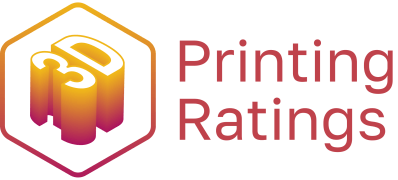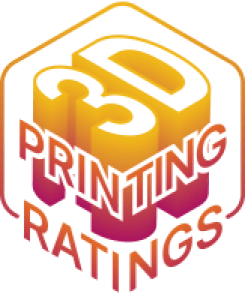Now that so many 3D printing technologies and printers are available, it might be challenging to narrow down your options when you want to purchase one, especially if you are new to the field. However, it is undeniable that 3D Systems and Monoprice are two of the largest 3D printer manufacturers in the world today. As a result, we chose to conduct a manufacturer comparison of 3D Systems vs. Monoprice, analyzing their strengths and weaknesses and offering advice to potential customers.
3D Systems 3D Printer
3D Systems, based in Rock Hill, South Carolina, is a company that engineers, manufactures, and sells 3D printers. They also sell 3D printing materials, 3D scanners and offer a 3D printing service. The company produces master patterns for tooling, functional and precise prototypes of products, concept models of new products, and production parts for direct digital manufacturing. It employs proprietary procedures to create physical objects by utilizing data from 3D scanning and 3D sculpting equipment and computer-aided design and manufacturing software.
The company provides software, materials, and the online quick part printing service On Demand, in addition to a variety of professional and production-grade 3D printers. It significantly contributed to the development of stereolithography and the STL file format in the field of 3D printing. Many industries, including aerospace, automotive, healthcare, dental, entertainment, and durable goods, employ 3D Systems’ technologies and services during the design, development, and production phases.
Technology
3D Systems manufactures stereolithography (SLA), selective laser sintering (SLS), color-jet printing (CJP), fused deposition modeling (FDM), multi-jet printing (MJP), and direct metal printing (DMP). Each technique uses digital input derived from three-dimensional data to build three-dimensional components one layer at a time. The materials, print capacities, and application of the systems differ, as stated below.
SLA: Chuck Hull is the founder of stereolithography (SLA) 3D Printing and Co-Founder of the 3D Systems 3D Printing company. The process of creating physical objects in a vat of liquid photopolymer using ultraviolet-curable material and a laser to trace the digital design is known as stereolithography. SLA systems are advantageous because they print with support and can produce prints of any size quickly (size depends on the build volume of the particular machine). SLA systems are made to produce prototypes, patterns, or finished parts of various sizes and applications. They can also quickly manufacture parts with various geometries at the same time. SLA components can be used as master patterns for injection molding, thermoforming, blow molding and different metal casting techniques since they are durable enough to withstand machining.
SLS: SLS, or selective laser sintering, is an additive manufacturing process that fuses tiny particles together using a powerful laser. SLS is frequently an effective method since numerous parts can be produced in a single session. SLS does not need any support structures because the parts are always encircled by unsintered powder. Many material alternatives exist, such as plastic, metal, ceramic, nylon, polystyrene, or glass particles.
CJP: Inkjet technology is used in color jet printing to spray a liquid binder over a powder bed. Each fresh layer is created by releasing and spreading powder using a roller. Z Corporation was the original developer of this technology.
FDM: The hobbyist-level printer line from 3D Systems handles fused deposition modeling. These printers deposit a thermoplastic, one layer at a time, along complex toolpaths using a heated extruder. Building a 3D model using hot glue is an excellent way to see this in action. The model can be created layer by layer when a layer has cooled and hardened. Building would have to be done one layer at a time, with the hot glue gun (a hand-powered extruder) depositing a string that was nearly the same width as the extruder orifice. FDM has drawbacks in terms of time (it must follow complex toolpaths), color (only one color can be printed at a time), and durability (interlayer adhesion is analogous to a cold solder).
MJP: Multi-Jet printing technique uses inkjet technology to deposit liquid photopolymers onto a build surface. This allows the user to produce rubbery or hard plastic components for a wider range of applications. High resolution can be achieved with a support material that may be easily removed during post-processing. In contrast to FDM, these parts are typically too brittle for snap-fits. With more recent MJP printer models, lesser durometer (softer) parts are, however, conceivable.
DMP: The method used by 3D Systems to print metal is known as Direct Metal Sintering. Using an overhead laser beam, this procedure spreads out fine powders of various metal alloys onto a printbed and joins geometries. This technology is generally used in the medical and aerospace industries, where limited volumes of distinctive and sophisticated models are required.
Monoprice Select Mini 3D Printer Review
Assuming that you are looking for a cheap 3D printer. It is challenging because some models are not good enough to warrant a very low price. Other models require manual assembly from component parts. What if you found a far less expensive printer than the competition? Would you trust it?
Yes, you should trust the Monoprice Select Mini. Why should you trust it? Sit back and watch this Monoprice 3D Printer Review Video
Design
The design of this printer is as basic as they come. It prints onto a heated bed and features a single extruder. The build area is less than you might expect—roughly the size of a Coke can. There are no complaints on this front; this is typical for a printer in this price range.
The printer is packaged fully constructed and pre-calibrated because it is intended for beginners. In fact, you should not need to adjust it very frequently because of the four-post leveling system. Instead, concentrate on the fun part: actually printing items
You can control this printer directly or via a PC, using the built-in screen to select models for printing. Additionally, the printer comes with a USB stick with models so you can start printing right away. There is also an SD card slot and a USB port.
Printing
The Monoproce Mini is slow, which is the first thing you need to know. Its highest speed is just half as fast as its competitors, and to make matters worse, even at that pace, it frequently breaks down. A slow and steady approach will serve you far better. The most reliable, top-notch models appear to be produced as a result.
Now, keep in mind that this 3D printer is inexpensive. Despite this, its prints turned out really nicely! Sure, you can still see the layers, and fine details are not replicated all that well, but with a bit of perseverance (and post-processing), you will discover you can actually accomplish quite a bit with the Select Mini.
Lack of versatility is a frequent trait among budget 3D printers. At best, you should be able to print using PLA and possibly ABS as well. Amazingly, along with HIPS, PVA, and TPU, the Monoprice Select Mini supports both of these materials. It’s not even limited to using a proprietary filament, so you can really go wild.
Features
The simplicity of this printer is one of its appeals. As a result, there are not many cutting-edge features to talk of. Instead, it strives to make things as simple as possible for first-time users. Consider software, for example – it is compatible with Cura, Repetier, Simplify3D, and the majority of other well-known modeling or slicing applications.
Upgrades may be desired as you become more adept at utilizing a 3D printer. Because its internal components are easy to access and its firmware easily flashed, the Select Mini is ideal.
If you have used 3D printers previously, this model probably will not blow you away when you compare 3D printers. After all, it is designed with beginners in mind and is priced accordingly.
Specifications
- Filament Diameter 1.75mm
- Extruders 1
- Supported Materials PLA, ABS, HIPS, PVA, TPU
- Connectivity USB, SD Card
- Printing Speed 55mm/s
- Build Volume 4.7 x 4.7 x 4.7”
Cost
This Monoprice Select Mini 3D Printer retails for around $190, putting it among the cheapest 3D printers on the market.
You can reduce your material expenses because you are free to use filament from third parties. This will rise to some extent if you wish to print frequently, but because there is no support for uncommon filaments, things should not get out of hand too quickly.
This printer has the versatility and ideal pricing to dominate the low-end industry. We are shocked that this is not the standard advice for those who want to start using 3D printing for the first time.
This printer is perfectly priced and has enough versatility to corner the low-end market.




